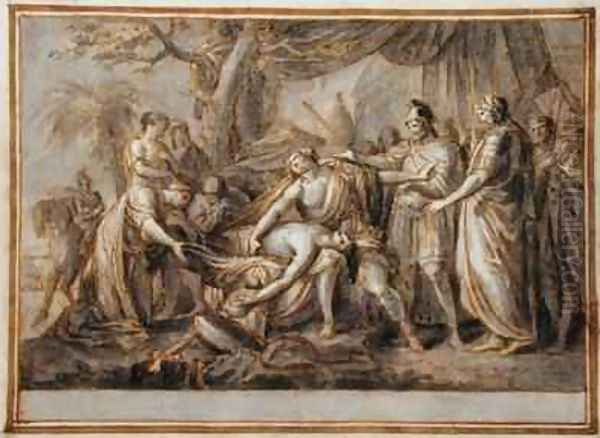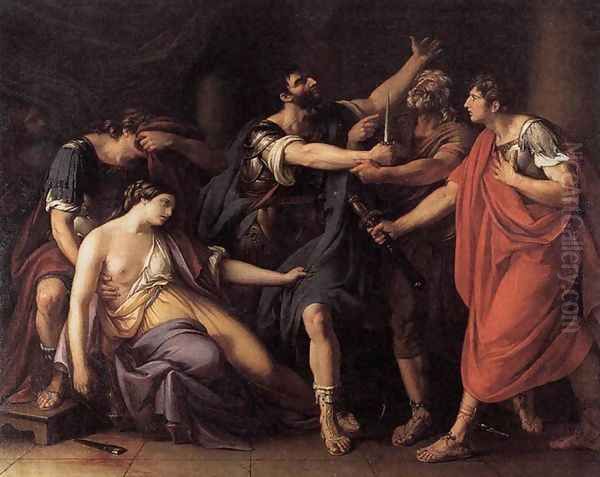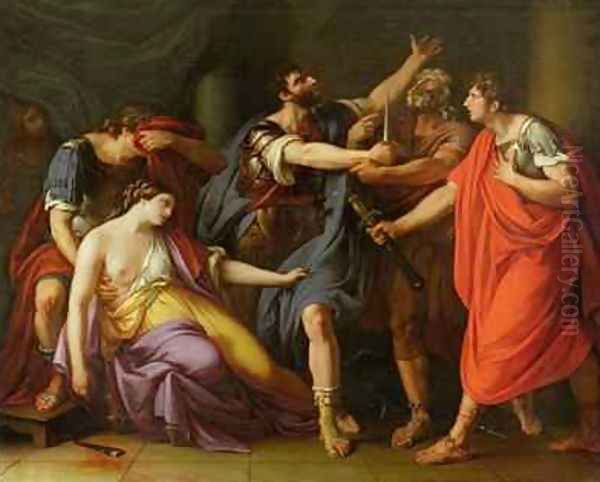Gavin Hamilton (1723-1798) stands as a pivotal yet often underappreciated figure in the annals of 18th-century European art. A man of diverse talents, this Scottish-born artist was not only a history painter of considerable renown in his time but also a dedicated archaeologist and an influential art dealer. His life and career, largely spent in Rome, placed him at the very heart of the burgeoning Neoclassical movement, where he contributed significantly to its visual and intellectual development. Though his fame in his native Britain was perhaps less pronounced than on the continent, his impact on the artistic tastes and collections of the era was profound.
Early Life and Artistic Formation
Born in 1723 at Murdieston House in Lanarkshire, Scotland, Gavin Hamilton hailed from a well-established Scottish family. His early artistic inclinations led him to pursue an education in the arts in Glasgow. However, like many aspiring artists of his generation, Hamilton recognized that Rome was the ultimate destination for anyone serious about mastering the classical tradition and immersing themselves in the fount of Western art.
He first journeyed to Italy between 1748 and 1750, a period that proved formative. In Rome, he sought out the tutelage of Agostino Masucci (1691-1758), a respected painter working in a late Baroque style that was gradually giving way to newer artistic currents. Masucci, himself a pupil of Carlo Maratta, provided Hamilton with a solid grounding in academic principles of drawing and composition. This initial Roman sojourn was crucial, exposing Hamilton to the city's unparalleled artistic heritage – from the remnants of ancient glory to the masterpieces of the Renaissance and Baroque periods.
Rome: The Epicenter of Neoclassicism
After a brief return to Britain, Hamilton decided to settle more permanently in Rome around the mid-1750s. This was a city buzzing with intellectual and artistic fervor. It was the era of the Grand Tour, where young noblemen and aspiring connoisseurs from across Europe, particularly Britain, flocked to Italy to complete their education and acquire taste. Rome, with its ancient ruins and celebrated art collections, was the principal magnet.

It was in this stimulating environment that Neoclassicism began to crystallize as a dominant artistic force. This movement was a reaction against the perceived frivolity and ornamental excess of the preceding Rococo style. Instead, Neoclassicism championed a return to the perceived purity, simplicity, and moral gravity of the art of ancient Greece and Rome, and to a lesser extent, the High Renaissance masters like Raphael. Key figures in articulating the theoretical underpinnings of this movement were the German scholar Johann Joachim Winckelmann (1717-1768) and the painter Anton Raphael Mengs (1728-1779). Hamilton became an integral part of this circle, sharing their enthusiasm for antiquity and their desire to reform contemporary art.
Winckelmann’s writings, particularly "Thoughts on the Imitation of Greek Works in Painting and Sculpture" (1755) and "History of Ancient Art" (1764), provided the intellectual framework for Neoclassicism. He extolled the "noble simplicity and quiet grandeur" of Greek art, advocating for an art that was not merely a slavish copy of ancient models but one that captured their essential spirit. Mengs, a close friend of Winckelmann, sought to translate these ideals into paint, creating works characterized by clear compositions, idealized figures, and restrained emotion. Hamilton, working alongside these figures, absorbed these principles and began to forge his own distinct Neoclassical style.
Hamilton the Painter: Defining Neoclassical History Painting
Gavin Hamilton dedicated himself primarily to history painting, considered the noblest genre in the academic hierarchy of the arts. His subjects were drawn predominantly from Greek and Roman history and mythology, particularly from the epic poems of Homer. His artistic approach was deeply influenced by the classical tradition, not only through the direct study of ancient sculpture but also through the example of 17th-century classicizing painters like the French master Nicolas Poussin (1594-1665).
Poussin’s carefully constructed compositions, his emphasis on clear narrative, and his use of figures often derived from ancient statuary provided a powerful model for Hamilton and other Neoclassicists. Hamilton’s paintings are characterized by their frieze-like arrangements of figures, often set in shallow stage-like spaces, which emphasized clarity and legibility. His figures are typically idealized, with a sculptural quality that recalls ancient marbles. The color palettes are often somber and restrained, contributing to the overall sense of gravity and moral seriousness that Neoclassicism sought to convey. He aimed for a style that was both heroic and pathetic, capable of inspiring virtue and evoking profound emotion.
Masterpieces of Moral Virtue and Heroic Pathos

Among Hamilton’s most significant contributions to Neoclassical painting was his series of six large canvases depicting scenes from Homer’s Iliad. These works, executed over a number of years, were highly influential and widely disseminated through engravings by Domenico Cunego. One of the most celebrated paintings from this series is Achilles Lamenting the Death of Patroclus (c. 1760-1763). This work powerfully captures the grief of the Greek hero Achilles over his fallen companion, embodying the Neoclassical interest in profound human emotion expressed with dignity and restraint. The composition is stark, focusing on the central figures, their gestures conveying deep sorrow.
Another key painting from his Homeric cycle is Andromache Bewailing the Death of Hector (c. 1761). Here, Hamilton depicts the tragic moment when Hector's wife, Andromache, mourns her husband, the Trojan hero. The scene is imbued with a sense of pathos and loss, typical of Hamilton's ability to convey strong emotional states within a controlled, classical framework. These Homeric scenes were not merely illustrations of ancient texts; they were intended as exemplars of virtue, heroism, and the tragic consequences of conflict, resonating with the Enlightenment's emphasis on reason and morality.
Perhaps Hamilton’s most famous individual work is The Oath of Brutus (completed c. 1763-1764). This painting depicts the pivotal moment in Roman history when Lucius Junius Brutus, after the rape and suicide of Lucretia, swears an oath with her male relatives to overthrow the tyrannical Tarquin monarchy and establish the Roman Republic. The subject matter itself—patriotic duty, sacrifice, and the fight against tyranny—was a favorite of Neoclassical artists. Hamilton’s composition is dramatic and focused, with Brutus and his companions arranged in a dynamic group around the body of Lucretia. This work predates and arguably influenced Jacques-Louis David’s (1748-1825) iconic Oath of the Horatii (1784), another seminal work of Neoclassical history painting that explores similar themes of civic virtue and self-sacrifice.
Other notable works by Hamilton include Agrippina Landing at Brundisium with the Ashes of Germanicus (1768), which showcases his ability to handle complex multi-figure compositions and convey a sense of solemn dignity. His portraits, though less numerous than his history paintings, also demonstrate his skill, such as his depiction of Douglas, 8th Duke of Hamilton, with his tutor Dr. John Moore and a certain Mr. Sempill, set against a Roman backdrop.
The Archaeologist and Antiquarian

Beyond his achievements as a painter, Gavin Hamilton was an avid and remarkably successful archaeologist and dealer in antiquities. From the 1760s onwards, he undertook numerous excavations at significant ancient sites in and around Rome, including Hadrian’s Villa at Tivoli, Ostia (the ancient port of Rome), Gabii, and other locations in the Roman Campagna. These were not scientific excavations in the modern sense, but rather treasure-hunting expeditions aimed at unearthing ancient sculptures and other artifacts for sale, primarily to wealthy British Grand Tourists and collectors.
His discoveries were often spectacular. He unearthed a plethora of Roman statues, busts, reliefs, and mosaics, many of which found their way into prominent British collections, such as those of Charles Townley and William Petty, 2nd Earl of Shelburne (later 1st Marquess of Lansdowne). The "Townley Venus," the "Townley Marbles" (many of which are now in the British Museum), and the Lansdowne Collection were significantly enriched by Hamilton's finds. His activities helped to fuel the craze for collecting antiquities that characterized the 18th century and played a crucial role in shaping the Neoclassical taste for ancient art.
Hamilton meticulously documented his finds in letters to patrons and fellow antiquarians like Charles Townley and William Hamilton (no direct relation, but the British envoy to Naples and a famous collector himself, particularly of Greek vases). These letters provide invaluable information about the provenances of many important ancient sculptures. His archaeological endeavors were not without controversy, as methods were often destructive by modern standards, and the primary goal was the acquisition of saleable objects. Nevertheless, his work significantly contributed to the corpus of known ancient art and provided tangible models for Neoclassical artists. He also published Schola Italica Picturae (1773), a volume of engravings after Italian Old Masters from Michelangelo to the Carracci, intended to promote the study of Italian painting.
The Astute Art Dealer and Cultural Intermediary
Hamilton’s roles as painter and archaeologist were intrinsically linked to his activities as an art dealer. He acted as an agent and advisor for many prominent British collectors, guiding their acquisitions and helping to form some of the most important private collections of the day. His knowledge of both ancient and Renaissance art, combined with his network of contacts in Rome, made him an indispensable figure for Grand Tourists looking to acquire art.
He dealt not only in the antiquities he excavated but also in Old Master paintings and contemporary works. His correspondence reveals a shrewd businessman, adept at negotiating prices and managing the complex logistics of shipping artworks back to Britain. He often encouraged his patrons to commission works from contemporary artists in Rome, including himself. His influence extended to advising on the display of collections, further shaping the aesthetic environment of British country houses.
His clients included figures like the aforementioned Earl of Shelburne, for whom he acquired a significant collection of ancient sculptures that adorned Lansdowne House in London. He also worked with Thomas Pitt (Lord Camelford) and many others. Through these activities, Hamilton played a significant role in transplanting Roman artistic taste and classical artifacts to Britain, profoundly influencing British art and architecture.
Connections, Influence, and Anecdotes
Throughout his long career in Rome, Hamilton cultivated relationships with a wide array of individuals. He was a respected member of the artistic community, which included not only Mengs and Winckelmann but also other prominent figures. He knew the celebrated Italian printmaker Giovanni Battista Piranesi (1720-1778), whose dramatic etchings of Roman ruins also fueled the European imagination for antiquity. He would have been aware of leading Roman painters like Pompeo Batoni (1708-1787), who specialized in portraits of Grand Tourists, often depicted amidst classical ruins or with famous statues.
Hamilton also served as a mentor and guide to younger artists arriving in Rome, particularly those from Britain. He offered advice, facilitated introductions, and sometimes provided practical assistance. His studio was a point of contact for visiting artists and connoisseurs. Among those who benefited from his presence in Rome was the young Antonio Canova (1757-1822), the leading Neoclassical sculptor. While Canova developed his own distinct style, Hamilton’s emphasis on classical ideals and his access to ancient sculptures undoubtedly contributed to the artistic environment in which Canova flourished. Other artists like Angelica Kauffman (1741-1807) and Benjamin West (1738-1820), who both spent formative years in Rome, were part of this international Neoclassical milieu. Even landscape painters like Jacob More (1740-1793), a fellow Scot in Rome, or those influenced by the idealized landscapes of Claude Lorrain (1600-1682), operated within this classicizing atmosphere.
One peculiar anecdote from Hamilton's life involves his arrest in connection with an alleged conspiracy to murder Lord Moray. While the details are somewhat obscure, he was eventually cleared of any wrongdoing. This incident, however, hints at the sometimes-turbulent undercurrents of life in 18th-century Rome, even for a respected figure like Hamilton. Despite such episodes, he was generally regarded as a man of integrity and considerable learning.
Later Years and Legacy
Gavin Hamilton remained in Rome for the majority of his life, continuing to paint, excavate, and deal in art until his death on January 4, 1798. He witnessed the French occupation of Rome, an event that profoundly disrupted the city's artistic and social life.
Despite his significant reputation across Europe during his lifetime, particularly in Italy and among continental connoisseurs, Hamilton's fame in Britain was somewhat eclipsed after his death, especially with the rise of Romanticism. His paintings, with their stern Neoclassical morality and idealized forms, perhaps seemed less appealing to subsequent generations. However, art historians now recognize his crucial role in the development of Neoclassicism. His history paintings were among the earliest and most influential examples of the style, providing a model for many other artists, including David.
His archaeological activities, while driven by commercial imperatives, unearthed countless treasures that enriched public and private collections, contributing significantly to the study and appreciation of ancient art. As an art dealer and cultural intermediary, he was instrumental in shaping British taste and collections. Artists like Henry Fuseli (1741-1825), though more aligned with Romanticism, also engaged with classical themes and would have been aware of Hamilton's contributions. Even later history painters, such as William Etty (1787-1849), though working in a different style, were heirs to the tradition of grand historical and mythological subjects that Hamilton championed.
In conclusion, Gavin Hamilton was a multifaceted and influential figure whose career intersected the worlds of painting, archaeology, and the art market. As a pioneer of Neoclassical history painting, he created works that embodied the ideals of a new artistic era. As an archaeologist and dealer, he played a vital part in the rediscovery and dissemination of ancient art. Though he spent most of his life away from his native Scotland, his impact on European art and taste in the 18th century was undeniable, securing his place as a key proponent of the Neoclassical movement. His dedication to the "grand style" and his deep engagement with the classical past left an indelible mark on the art of his time.